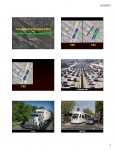Responding to the myriad of criticisms that have been leveled against the Columbia River Crossing Light Rail Tolling project (CRC), urban design architect George Crandall and mass transit advocate Jim Howell have developed a plan that they have labeled the Common Sense Alternative (CSA). The pair first joined forces in the early 1970s to help kill the Mount Hood Freeway—a large Department of Transportation construction initiative that many grassroots activists considered ill-advised.

George Crandall and Jim Howell developed the Common Sense Alternative (CSA) to combat dysfuntional CRC plan.
Drawing upon a lifetime of urban design experience that has been recognized by the American Institute of Architects (AIA), Crandall is convinced that his five-stage Common Sense Alternate plan addresses all of the problems outlined in the CRC’s “Purpose and Needs” statement but in a much cheaper and more efficient manner. By taking a “more practical approach that puts more emphasis on crossing the river and less on freeway expansion,” Crandall’s CSA plan would distribute commuter, freight and rail traffic over three separate bridges, rather than relying upon the single-crossing model proposed by the CRC.
Despite assurances from the CRC, Crandall is convinced that continuing to consolidate traffic using a single bridge is the equivalent of “attaching a garden hose to a fire hydrant.” His plan, by contrast, would ease traffic flow by dispersing it over several different locations. Depending on their immediate destinations, cars, trucks, rail services, cyclists and pedestrians would be routinely diverted to one of five bridges. Perhaps most importantly, the multi-bridge plan would make continued use of existing bridges and allow construction projects to occur in a progressive series of phases. The first phase would renovate the existing BNSF Railway Company (BNSF) Rail Bridge to increase safety and install a new lift that would better align boating routes with the high point of the neighboring Interstate 5 Bridge. This much-needed upgrade would eliminate 95% of the drawbridge lifts that currently occur on the I-5 Bridge and thereby greatly improve traffic flow.The second phase of the Common Sense Alternative would be to construct a new local bridge to Hayden Island. This crossing would accommodate light rail, motor vehicles, bicycles, and pedestrians.
Phase three calls for the construction of a rail and truck bridge linking Portland and Vancouver. The purpose of this bridge is threefold: to enable freight trucks to bypass the existing I-5 Bridge; to provide additional service routes for cars, bikes, and pedestrians; and to more effectively support passenger trains. By channeling all commuter rail traffic over this new bridge, the overall freight capacity of the existing BNSF Rail Bridge will be greatly increased.
Phase four would save the existing I-5 bridge system by making significant seismic upgrades. According to Crandall, this retrofit would make the structure the safest bridge in the state of Oregon.
The fifth and final phase of the CSA would build a new multi-use bridge connecting Vancouver with Hayden Island. Traffic traveling over this bridge would ideally be limited to automobiles, light trucks, bus and rail transit, bicycles and pedestrians.
Build more bridges
Although the Common Sense Alternative calls for the construction of three separate bridges (as compared to the single bridge plan favored by the CRC), the proposal aims to keep costs low by maximizing use of existing infrastructure and employing simpler, more economic architectural designs. Crandall estimates that the price tag for all five proposed phases will total $1.8 billion. If this figure proves correct, the CSA plan would cut the present $3.6 billon CRC estimate neatly in half while providing the same composite number of traffic lanes and greater peak-hour capacity.
Crandall began his March 16th presentation by reminding the Joint Committee that the CSA is only one of many available alternatives to the CRC. However, with multiple endorsements from industry experts such as respected development consultant and Portland State University urban planning professor Will Macht, the CSA plan is certainly among the most visible and widely discussed.
In the end, Crandall’s primary objective is to ensure that city, state, and federal officials don’t ultimately find themselves shackled to a $10 billion-dollar fiasco.*
“The CRC should not be built because the CSA and other alternatives are cheaper, faster, and better,” Crandall said.
By focusing exclusively upon needs that are absolutely crucial and completing compartmentalized projects on an incremental basis, the CSA could provide a much more practical, economical and flexible way forward.
Download a copy of the Common Sense Alternative presentation by George Crandall and Jim Howell by clicking on the image to the left.
CREDITS
Video animation by Spencer Boomhower
Additional art by Nick Falbo and Joshua Cohen
Music performed by Lucas Gonze, >soupgreens.com
Video used with permission.
*The well-documented cost to taxpayers, if the CRC stays on budget, is $10 billion. This was established by the Cortright Report (PDF) which used data from an independent review panel hired by the governors of Washington and Oregon. (View the panel’s final report on which Cortright based his findings.)












